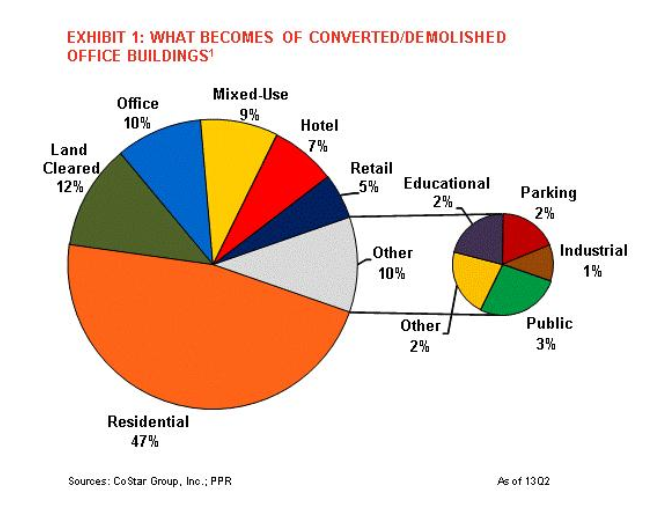
Earlier this week I posted on statistics that generated this chart from CoStar showing that 56% of office buildings that are converted or demolished make way for apartments and/or mixed use. These type of projects do come with their own set of risks and rewards however. Fortunately that same day Globe St. posted an interview with Jim Grauley, COO and president of Columbia Residential on the down and dirty details of repositioning buildings for residential. Columbia does a lot of LIHTC (Low Income Housing Tax Credit) projects but they started up Columbia Ventures LLC to focus specifically on repositioning existing buildings for market rate housing. In a two part interview (part 1 and part 2) he laid out the requirements, risks and opportunities.
One project they currently have underway is the Imperial Hotel in downtown Atlanta. It required a complicated financing transaction for a complete historic and LEED Gold renovation that will create 90 state of the art efficiency apartments. “Columbia also is taking on an adaptive reuse of another historically significant building in Downtown Atlanta converted to market rate apartments” said Grauley.
Their objective is to create “a sustainable urban lifestyle [that] is achievable when transit, occupation, services and entertainment are all in close proximity to home, making car ownership an option rather than a necessity.”
Here are my bullet points from the how-to knowledge he shared:
- Target a building that has unique/non-replaceable characteristics.
- That is located in a strong, hard to replicate, location.
- The acquisition cost of the building structure must be significantly lower than replacement costs.
- Market rents are a big driver of what can be done. higher rents drive acquisition, land, and construction costs higher, so in many cases reuse can be more feasible than new construction.
- Often reuse projects will have a larger portion of capitalization via equity sources, given the renovation risks or uncertainties and lender tendency to be more conservative with the unknowns in underwriting (= lower LTV or LTC).
- The biggest risk is dealing with the unexpected in design, construction, and operations from older buildings. You must plan for this to happen with contingencies and very substantial up front due diligence on the building.
- The building must have a layout that will allow the creation of desirable living spaces, with good light, volume, character, and connectivity (Ties in with the 22k floor plate ideal that was mentioned in my first post).
- Creativity and knowing the market are key challenges in building out the kind of living spaces that will find market acceptance.
- In older cities or districts, there are often more incentives for preservation and reuse and redevelopment.
- In historic buildings, projects can utilize historic renovation credits and incentives to allow for feasibility.
- It’s optimal when there are incentives and subsidies for renovation—such as state/federal historic tax credits, new markets tax credits.
- ROI can be very good, but the often necessary subsidies for renovation or preservation can limit the re-sale timing and in some cases return..